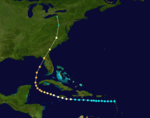1896 Atlantic hurricane season
| 1896 Atlantic hurricane season | |
|---|---|
| Seasonal boundaries | |
| First system formed | {{{First storm formed}}} |
| Last system dissipated | {{{Last storm dissipated}}} |
| Seasonal statistics | |
| Total fatalities | Unknown |
| Total damage | Unknown |
The 1896 Atlantic hurricane season ran through the summer and the first half of fall in 1896. The season was a fairly inactive one, with 7 storms forming, with the first six becoming hurricanes.
Storms
Hurricane One
| Category 2 hurricane (SSHWS) | |
| Duration | July 4 – July 9 |
|---|---|
| Peak intensity | 100 mph (155 km/h) (1-min); 973 mbar (hPa) |
The first storm formed on July 4 and lasted until July 12. It formed directly below Cuba and moved north, making landfall in the Florida Panhandle, then continued straight north into Canada. Its maximum sustained winds were at 100 mph (161 km/h). Heavy rainfall fell from the Florida panhandle northeast across northern Georgia, the interior Carolinas, and southern Virginia. The maximum rainfall fell at [Greenwood, South Carolina], where 12.0 inches (300 mm) was recorded.[1]Damage is estimated at around $100,000 (1896 dollars).
Hurricane Two
| Category 3 hurricane (SSHWS) | |
| Duration | August 30 – September 10 |
|---|---|
| Peak intensity | 115 mph (185 km/h) (1-min); 956 mbar (hPa) |
The second storm formed on August 30 and lasted until September 11. It formed directly to the east of the Lesser Antilles and hit Puerto Rico, the Dominican Republic, Haiti, some of the Bahamas, and Maine. Its maximum sustained winds were at 115 mph.
Hurricane Three
| Category 2 hurricane (SSHWS) | |
| Duration | September 18 – September 28 |
|---|---|
| Peak intensity | 100 mph (155 km/h) (1-min); |
The third storm formed on September 18 and lasted until September 28. It formed right on the east of the Lesser Antilles. It stayed out at sea and did not hit any land. Its maximum sustained winds were at 95 mph.
Hurricane Four
| Category 3 hurricane (SSHWS) | |
| Duration | September 22 – September 30 |
|---|---|
| Peak intensity | 125 mph (205 km/h) (1-min); 960 mbar (hPa) |
The fourth storm formed on September 22 and lasted until September 30. It formed directly over the Lesser Antilles and hit Cuba, Florida, Georgia, South and North Carolina, Virginia, Washington D.C., and Pennsylvania. Its maximum sustained winds were at 130 mph. The heaviest rainfall deposited in association with the storm was 19.96 inches (507 mm) at Glennville, Georgia.[2] This storm was responsible for an estimated 130 deaths and $1.5 million in damage (1896 dollars).
Hurricane Five
| Category 2 hurricane (SSHWS) | |
| Duration | October 7 – October 13 |
|---|---|
| Peak intensity | 100 mph (155 km/h) (1-min); |
The fifth storm formed on October 7 and lasted until October 16. It formed in the Gulf of Mexico and went northwest, hit Florida, Nova Scotia, and Newfoundland. Its maximum sustained winds were at 100 mph (161 km/h).
Hurricane Six
| Category 2 hurricane (SSHWS) | |
| Duration | October 26 – November 9 |
|---|---|
| Peak intensity | 100 mph (155 km/h) (1-min); |
The sixth storm formed on October 26 and lasted until November 9. It formed to the northeast of South America, then went north-northeast out to sea and did a loop in the open Atlantic, and dissipated soon after. Its maximum sustained winds were at 100 mph (161 km/h).
Tropical Storm Seven
| Tropical storm (SSHWS) | |
| Duration | November 27 – November 29 |
|---|---|
| Peak intensity | 60 mph (95 km/h) (1-min); |
The final storm formed on November 27 and lasted until November 29. It formed over the southern Lesser Antilles, and moved northward through the islands, reaching a peak of 60 mph winds on the way and dissipating as it exited the islands.









